Are you interested in adding color and unique flavors to your culinary creations? Look no further than growing edible flowers in hydroponics! It’s a fascinating and rewarding way to cultivate these delightful blooms, regardless of your gardening experience. This step-by-step guide will walk you through growing edible flowers hydroponically, ensuring a successful harvest every time. From choosing the right hydroponic system to understanding nutrient solutions, lighting requirements, and pest management, we’ve got you covered. Prepare to embark on a blooming adventure and elevate your dishes to a new level!
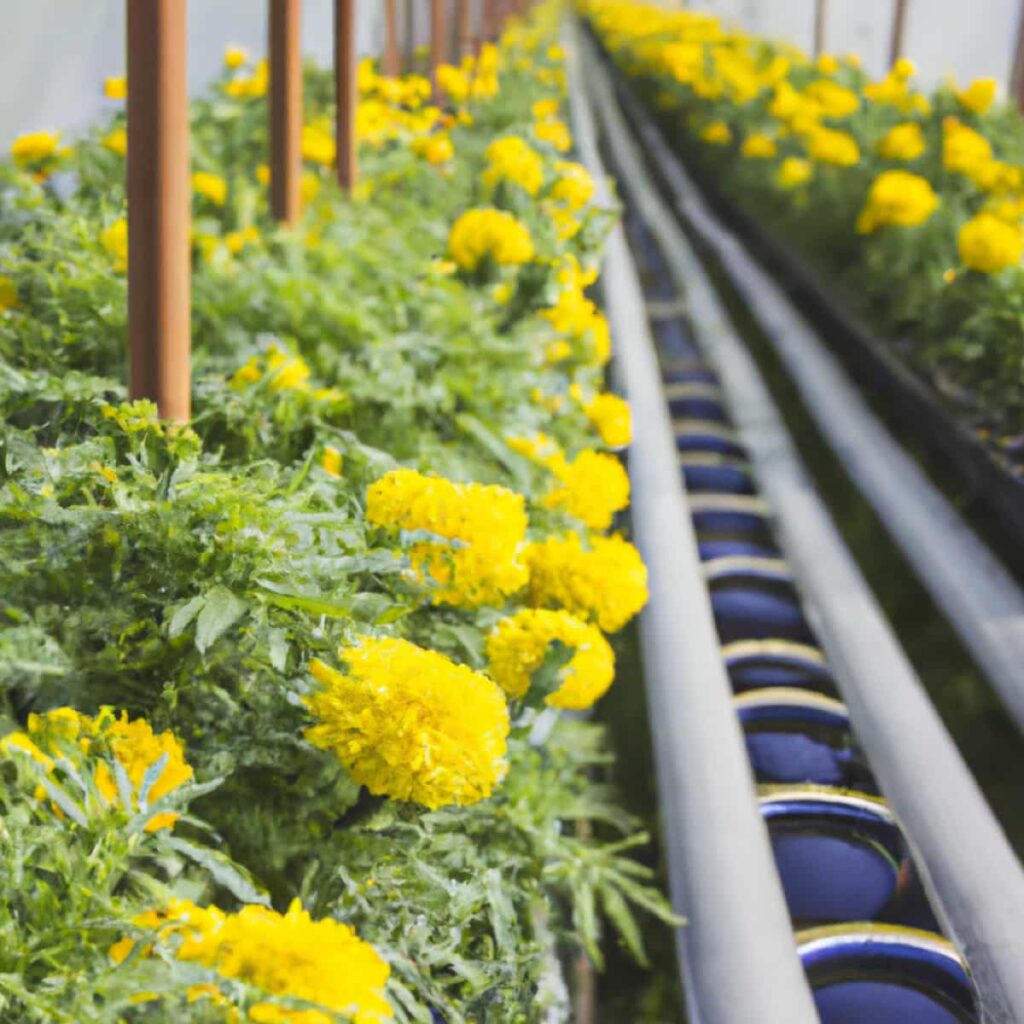
How to Grow Edible Flowers in Hydroponics
What are Edible Flowers in Hydroponics?
Edible flowers in hydroponics can be safely consumed and grown using the hydroponic system, a soilless cultivation method. These flowers are chosen for their taste, aroma, and visual appeal. They are grown in nutrient-rich water solutions instead of traditional soil. Edible flowers add unique flavors, textures, and colors to various dishes and beverages. They are used in salads, teas, desserts, and garnishes. Growing edible flowers hydroponically allows for year-round cultivation and precise control over nutrient levels, resulting in high-quality blooms.
Best Edible Flowers to Grow in Hydroponic Systems
When it comes to growing edible flowers in hydroponic, commonly grown flowers: Begonias, Butterfly Pea (Clitoria ternatea), Calendula, Carnations, Celosia, Daylilies, Lavender, Marigolds (including gem varieties, French and African types), Nasturtium, Nigella, Rose, Snapdragon, Viola, Yarrow, and Zinnia, also, some herbs do well in hydroponics, such as Basil, Cilantro, Dill, Fennel, Mexican Mint Marigold (also known as Southern tarragon), and Rosemary.
Benefits of Growing Hydroponic Edible Flowers
- Easy and Quick Growth: Hydroponic flowers grow faster and produce more leaves and blooms without complex root systems.
- Variety of Colors and Sizes: Growing flowers hydroponically allows easy separation of different varieties, offering customers a wide range of sizes and colors.
- No Soil-Based Diseases: Hydroponic systems eliminate the risk of soil-borne diseases, ensuring healthier plants and preventing disease transmission.
- Easier Weed and Pest Control: Hydroponics minimizes weed issues and makes identifying and removing any weed seeds or pests that may enter the system easier.
- Ability to Grow in Colder Climates: Hydroponics enables flower cultivation beyond traditional seasons by providing controlled indoor environments, extending the growing period.
- Higher Yields and Quality: Controlled environments in hydroponics increase flower yields and improve quality, with fewer pests and weather-related damage.
- Easier Nutrient Control: Hydroponics allows precise control over nutrient levels, preventing imbalances and ensuring each plant receives the necessary nutrients for optimal growth.
Hydroponic Systems for Cultivating Edible Flowers
Hydroponic systems offer versatile options for growing edible flowers. NFT (Nutrient Film Technique) systems are characterized by shallow channels that continuously flow nutrient-rich water over the lower roots of plants, creating a humid and oxygen-rich environment. This system is particularly beneficial for plants with low growth habits, such as violas, gem marigolds, dwarf nasturtiums, and herbs like basil and cilantro. NFT systems also facilitate easy harvesting due to their waist-height installation.
In case you missed it: How to Grow Leafy Green Vegetables in Hydroponics: A Step-by-step Growing Guide
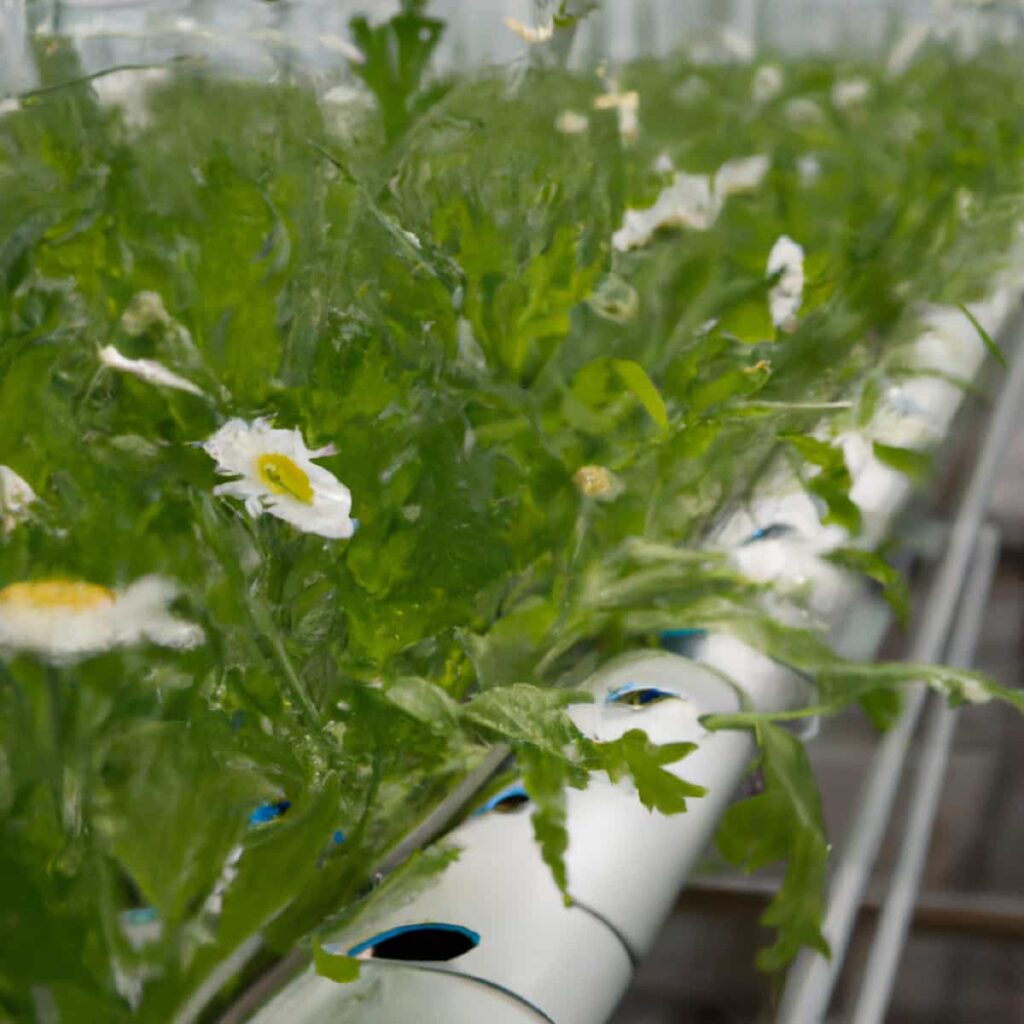
Deep water culture involves submerging the roots of plants in oxygenated water using net pots and floating trays. While commonly used for lettuce and leafy greens, this system can be adapted for growing flowers with proper maintenance.
Ebb and flow hydroponic systems use a pump and timer to flood reservoir trays at specific intervals. This system suits plants like begonias and dwarf nasturtiums, which benefit from intermittent drying between waterings. Adequate space between flood trays and lights allows for convenient tray removal during harvest.
Dutch buckets, often utilized for vining crops, are well-suited for flowers with long vining habits, such as butterfly peas and vining nasturtiums. These buckets are positioned closer to the ground for easy access during harvest. The Lower and Lean Method, commonly used for tomatoes, can also be employed for flowering vines by incorporating a trellis system in a hoop house.
Best Practices for Growing Edible Flowers Hydroponically
- Optimal Nutrient Solutions: Ensure balanced nutrient solutions specifically formulated for edible flowers. The nutrient solution should contain appropriate concentrations of essential macronutrients (nitrogen, phosphorus, potassium) and micronutrients (iron, manganese, zinc).
- Adequate Lighting: Edible flowers require sufficient light for growth and development. LED grow lights are highly recommended as they provide the necessary light spectrum and can be tailored to specific flower varieties. Aim for a light intensity of 200-400 µmol/m²/s for optimal results.
- Proper pH Management: Maintain the pH level of the nutrient solution within the recommended range for the specific flower variety. Most edible flowers thrive in a slightly acidic to neutral pH range of 5.5-6.5. Regular monitoring and adjustment of pH are crucial.
- Temperature and Humidity Control: Maintain the ideal temperature range of 18-24°C (65-75°F) during the day and slightly lower at night. Adequate humidity levels between 50-70% promote healthy growth and prevent issues such as drying or excessive moisture.
- Pest and Disease Management: Implement preventive measures to minimize the risk of pests and diseases. Regular monitoring, proper sanitation, and organic pest control methods are recommended to avoid contamination of edible flowers.
- Harvesting at the Right Time: Harvest edible flowers when fully bloomed but before they wilt. Each flower variety may have specific maturity indicators, so careful observation is crucial to ensure optimal flavor and appearance.
- Water Quality: Use high-quality water free from contaminants and pathogens. Reverse osmosis (RO) or filtered water is often preferred to maintain the integrity of the nutrient solution and prevent potential issues.
Hydroponic Nutrient Solutions for Edible Flower Cultivation
Hydroponic systems require carefully balanced nutrient solutions to ensure healthy and productive edible flower growth. These solutions typically consist of essential macronutrients, including nitrogen (N), phosphorus (P), and potassium (K), along with necessary micronutrients like iron (Fe), manganese (Mn), and zinc (Zn). The nutrient concentrations are measured in parts per million (ppm) or milligrams per liter (mg/L). For example, a recommended nutrient solution for edible flowers may have N: 150-200 ppm, P: 50-100 ppm, K: 200-250 ppm, Fe: 2-5 ppm, Mn: 1-2 ppm, and Zn: 0.5-1 ppm.
Choosing Edible Flower Varieties in Hydroponics
- Hibiscus: With large, ornate blossoms, hibiscus is often used for tea, relishes, jams, and salads. Studies suggest that hibiscus may help reduce blood pressure and cholesterol levels.
- Lavender: Known for its calming fragrance, lavender is a popular addition to baked goods, syrups, teas, liqueurs, and spice mixtures.
- Honeysuckle: With nearly 200 species, honeysuckle flowers, and extracts are used to treat inflammatory conditions. They can be used in beverages, yogurt, sorbet, and as a sugar substitute in bread recipes.
- Rose: Rose petals have an aromatic, slightly sweet flavor. They can be eaten raw, added to salads, or dried in granola or mixed herbs. Certain compounds in roses may aid in reducing anxiety and promoting relaxation.
- Chamomile: Chamomile, a floral herb, has been used for centuries in cooking and traditional medicine. It is consumed to reduce anxiety and improve sleep quality. Chamomile blossoms can make syrups and infusions for baked goods, smoothies, and desserts.
In case you missed it: How to Grow Bok Choy Hydroponically: A Step-by-Step Guide for Planting to Harvesting
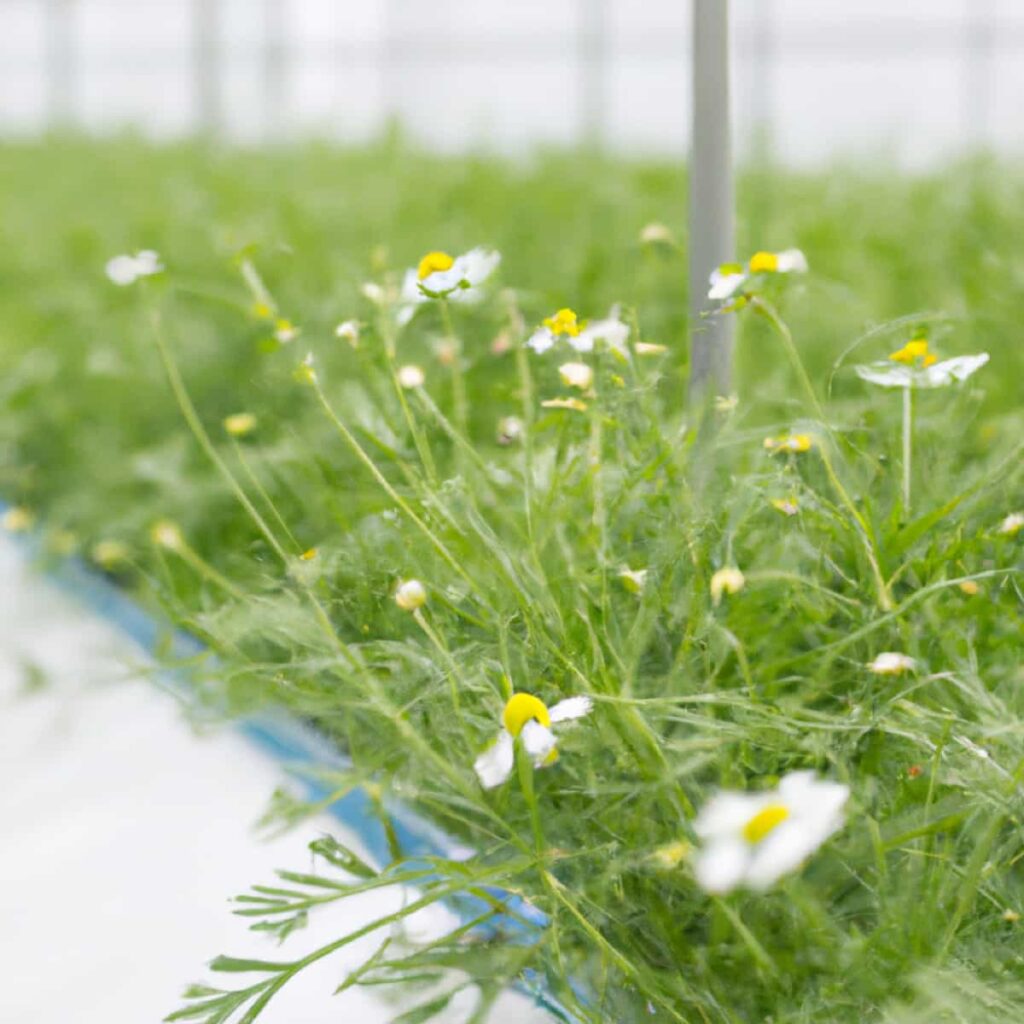
Optimal Lighting Requirements for Hydroponic Edible Flowers
- Hydroponic edible flowers depend on adequate light. Light intensity, duration, and spectrum matter.
- Edible flowers need 12–16 hours of light daily to grow and bloom. Consistent lighting improves plant health and productivity.
- Hydroponic systems use LED grow lights because of their energy efficiency and precise light wavelengths. Photosynthesis requires red and blue light, while green light improves plant health.
- Flower species require 200–1000 μmol/m2/s of light. Monitor and adjust light levels to meet edible floral needs.
Managing Pests and Diseases in Hydroponic Edible Flower Gardens
Managing pests and diseases in hydroponic edible flower gardens is advantageous compared to traditional soil culture. Hydroponic systems offer quick results and allow for precise control of nutrient delivery and pH balance, optimizing the environment for each flower species. Without the barrier of soil, plants save energy by efficiently absorbing nutrients through their roots.
Additionally, hydroponic systems eliminate weeds, insects, and diseases, creating a self-contained and pest-free environment. As a result, plants grown hydroponically can experience up to 50 percent faster growth and produce a higher yield of flowers than those grown in soil.
Harvesting and Storing Edible Flowers Grown in Hydroponics
Harvesting and storing edible flowers grown in hydroponics is a straightforward process similar to harvesting flowers grown in soil. Maintaining clean tools in the greenhouse or hydroponic system is crucial to prevent the spreading of infections or pests among plants. When harvesting, cut each flower down the stem to promote additional blooms. If you plan to sell edible flowers in clamshells, you can trim the stems at the base later for packing.
Have a bin nearby to discard flowers past their prime and any leaves showing signs of discoloration caused by disease or pests. Promptly remove them from the growing space. Following the correct nutrient requirements for each flower variety is essential in hydroponic flower cultivation. For instance, excessive nitrogen in the nutrient solution can delay flowering and stimulate vegetative growth.
Understanding Hydroponic pH and Its Impact on Edible Flower Growth
Understanding hydroponic pH and its impact on edible flower growth is important for successful cultivation. pH refers to the acidity or alkalinity of the nutrient solution. Most edible flowers thrive in a slightly acidic to neutral pH range of 5.5 to 6.5. pH affects nutrient availability, uptake, and plants’ overall health and growth.
When pH is too high or too low, nutrient deficiencies or toxicities may occur, leading to stunted growth and reduced flower production. Regular monitoring and adjustment of pH levels in hydroponic systems ensure optimal conditions for nutrient absorption and promote robust and vibrant edible flower growth.
Hydroponic Techniques for Extending the Blooming Period of Edible Flowers
One effective technique is adjusting the lighting schedule to provide longer photoperiods or supplementing with additional artificial lighting during darker seasons. Controlling the nutrient solution composition and ratio of essential nutrients, such as phosphorus and potassium, can promote flower development.
Adequate temperature and humidity management and proper pruning and deadheading techniques help redirect energy toward continuous blooming. Lastly, strategic use of plant growth regulators, like gibberellic acid, can stimulate flower production and prolong the blooming period of edible flowers in hydroponic systems.
In case you missed it: Hydroponic Farming at Home: How to Start, Kit, Cost, Best Plants for Home Hydroponics
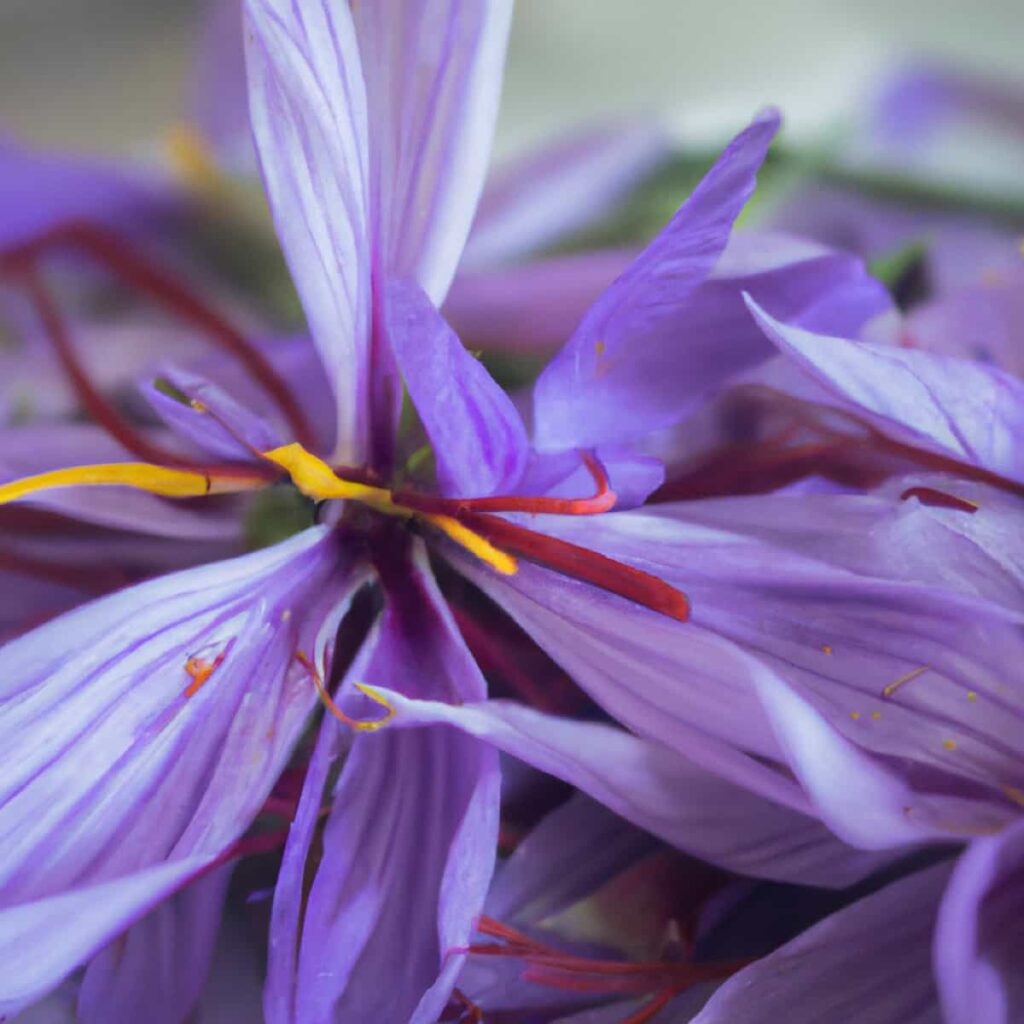
Maintaining Proper Humidity Levels in Hydroponic Edible Flower Setups
The ideal humidity range for most flowering plants is between 50% and 70%. To achieve this, proper ventilation is essential to prevent excessive moisture buildup. Adequate airflow helps control humidity by allowing moisture to escape and preventing stagnant air. Monitoring tools like hygrometers can provide real-time humidity readings, aiding in adjustments. Increasing humidity can be done by using humidifiers or by incorporating water features. Conversely, reducing humidity is achieved through dehumidifiers or by improving airflow.
Hydroponic Flower Nutrition: Essential Macronutrients and Micronutrients
Most hydroponic fertilizers are now available in liquid or powder form, allowing for easy dilution and addition to the growing system. These fertilizers contain organic ingredients like earthworm castings, blood meal, fish meal, kelp, or guano, similar to what is used in traditional soil feeding.
Additionally, hydroponic gardeners must supplement the trace elements typically present in healthy soils, as the growing media in hydroponics is inert. It is important to look for products explicitly mentioning trace mineral content on the label. Adjustments for plants with specific pH requirements can be made using sulfuric acid preparation or dolomite lime.
Hydroponic Flower Pollination Methods for Edible Plants
While natural pollination by insects and wind is limited in hydroponic setups, manual pollination methods can be employed. One common method is hand pollination, where a small brush or cotton swab transfers pollen between flowers. Another technique is gently shaking or tapping the plants to release the pollen and stimulate self-pollination. Sometimes, using an electric toothbrush or a specialized pollinator tool can help enhance pollination.
Controlling Temperature Fluctuations in Hydroponic Edible Flower Systems
Temperature affects plant development, including photosynthesis, nutrient uptake, and overall metabolism. Maintaining an ideal temperature range of 18-24°C (64-75°F) for most edible flowers in hydroponics is recommended. This can be achieved using temperature control devices such as heaters, fans, and ventilation systems. Monitoring temperature levels regularly and adjusting accordingly is essential, as extreme fluctuations can negatively impact plant health and productivity.
Hydroponic Flower Training Techniques for Optimal Growth and Yield
One effective method is pruning, which involves removing excess foliage and side shoots to direct energy toward flower production. Topping, another technique, involves cutting off the top portion of the main stem to encourage lateral growth and more flower sites. Additionally, using trellises, stakes, or support systems helps maintain plant structure and prevents sprawling, allowing better light penetration and air circulation. Training techniques like LST (Low-Stress Training) involve bending and securing stems to promote even canopy development.
In case you missed it: How to Maintain the pH Levels of Hydroponic Systems: Increase, Decrease, and Stabilize
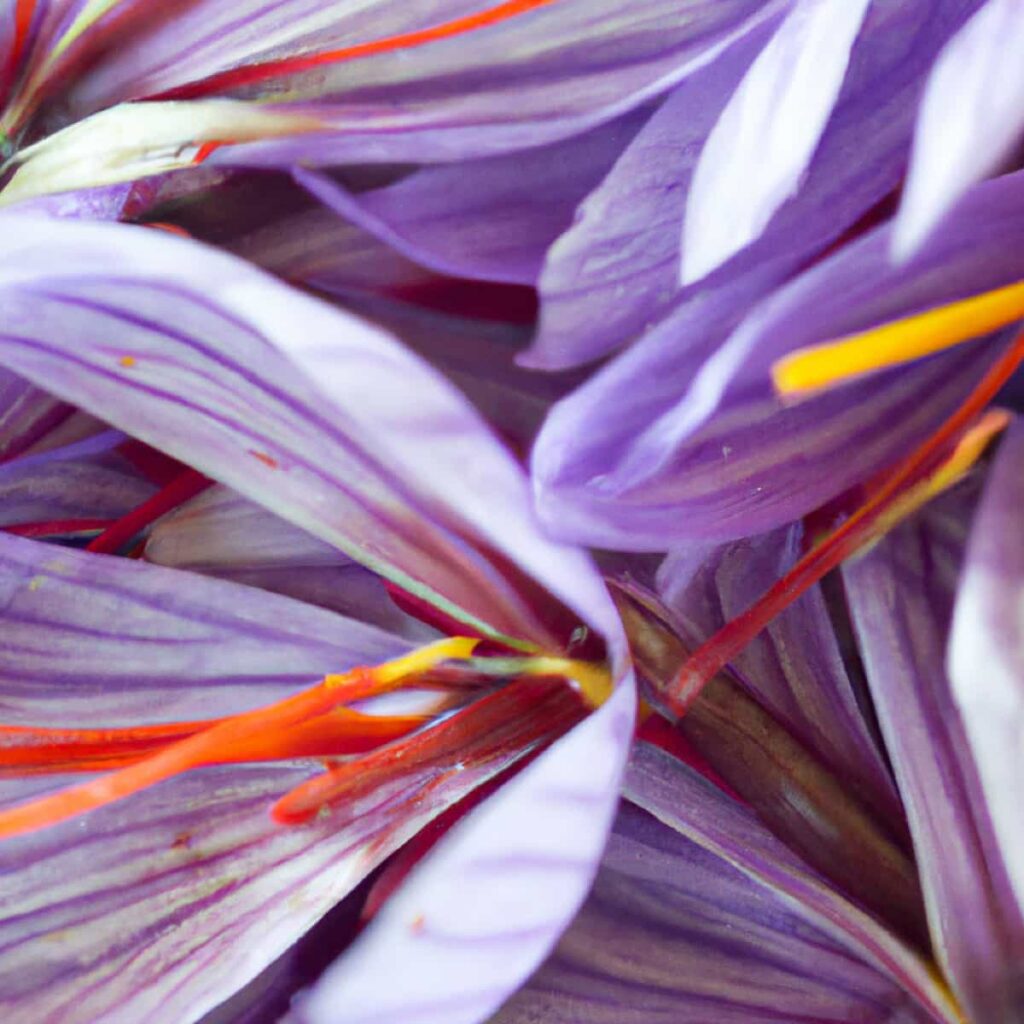
Differences Between Soil-based and Hydroponic Edible Flower Cultivation
In soil-based cultivation, plants rely on soil nutrients, which can vary in quality and composition. Hydroponics, on the other hand, provides precise control over nutrient delivery, optimizing plant growth and flower production. Soil-based cultivation requires more space, is susceptible to weed growth, and may require pest management.
Hydroponics eliminates weeds, pests, and soil-borne diseases, providing a cleaner and more controlled environment. While soil-based cultivation allows for natural nutrient absorption, hydroponics offers faster growth rates, higher flower yields, and the ability to grow flowers in locations with limited access to arable land.
Hydroponic Flower Transplanting and Propagation Techniques
Transplanting and propagating flowers in hydroponic systems requires careful techniques to ensure successful establishment and growth. One common method is to start with seedlings or cuttings and transplant them into the hydroponic medium, such as rockwool cubes or net pots filled with growing media. The root systems should be gently placed in the chosen medium, ensuring proper contact for nutrient absorption. Providing adequate moisture, humidity, and light during the initial stages promotes healthy root development and plant growth.
Common Hydroponic Mistakes to Avoid When Growing Edible Flowers
- Insufficient nutrient solution: Provide the right nutrients for your edible blooms. Measure and adjust the nutrition solution regularly to avoid deficits or excesses.
- pH imbalances: Your edible flowers’ pH can alter nutrient availability and plant health. Maintain nutrition solution pH.
- Over or underwatering: Find the perfect hydroponic watering balance. Overwatering causes oxygen deprivation, root rot, and nutrient leaching while underwatering causes nutrient imbalances and stunted development.
- Poor ventilation: Proper airflow prevents mold, bugs, and humidity. Healthy plant growth requires proper hydroponic system ventilation.
- Insufficient lighting: Edible flowers need light for photosynthesis and flowering. Buy good grow lights and place them far enough from the plants to offer enough light.
- Neglecting pest and disease control: Hydroponic gardens can still be affected by pests and diseases. Prevent infestations with regular inspections, sanitation, and organic pest management.
- Lack of monitoring and maintenance: Monitor and maintain your hydroponic system to fix problems quickly. Check for clogged lines, broken equipment, nutritional deficits, and plant stress.
Scaling Up Hydroponic Edible Flower Production for Commercial Purposes
Hydroponics can maximize production in limited space, resulting in higher yields per square foot compared to traditional soil-based methods. The controlled environment allows for year-round production, ensuring a consistent and reliable supply of edible flowers. Moreover, hydroponics reduces water usage by up to 90% compared to soil-based cultivation, making it an environmentally sustainable option. Automation and technology can be incorporated to streamline operations, optimize nutrient delivery, and monitor plant health, increasing efficiency and productivity.
Hydroponic Flower Business: Marketing and Selling Edible Flowers
Identify your target market, such as restaurants, specialty food stores, or direct-to-consumer sales. Develop a brand identity highlighting your edible flowers’ unique qualities and flavors. Create an appealing and informative website or social media presence to showcase your products.
Consider offering sample packs or customized assortments to attract customers. Collaborate with local chefs or food bloggers for endorsements and recipe collaborations. Attend food and agriculture trade shows or farmers’ markets to expand your customer base. Utilize effective packaging and labeling to differentiate your products and ensure compliance with food safety regulations. Constantly monitor customer feedback and adapt your marketing strategies accordingly.
In case you missed it: 20 Key Rules for Setting Up a Budget Hydroponic Garden at Home
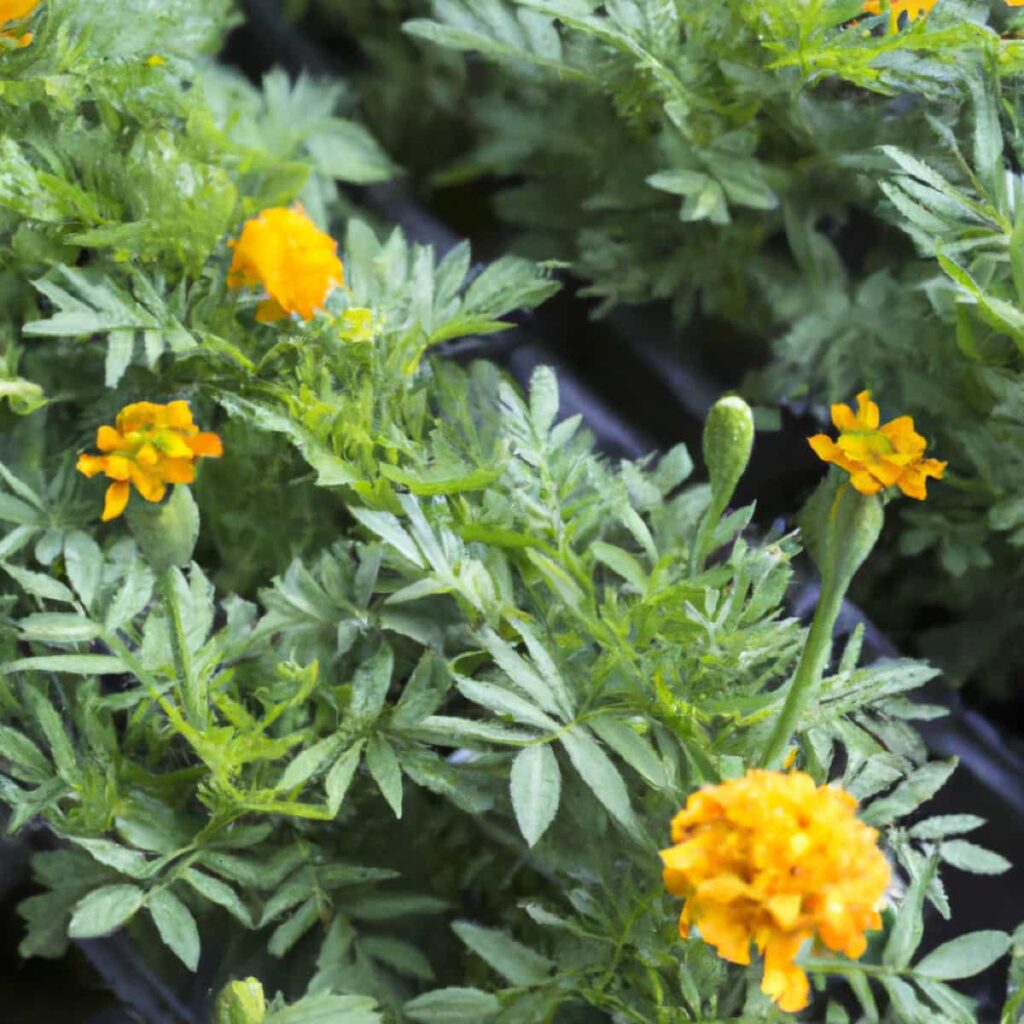
Conclusion
Growing edible flowers in hydroponics have benefits, including easy and quick growth, disease control, precise nutrient control, and the ability to grow in various climates. Following a step-by-step guide, anyone can cultivate a diverse range of beautiful and nutritious edible flowers. Some of the edible flowers you can grow in Hydroponics are:
| Anise Hyssop | Orange Flash Calendula |
| Chamomile | Saffron |
| Lavender | Viola Frizzle Sizzle Yellow-Blue Swirl |
| Marigold | Viola Sorbet Formula Mix |
- Profitable Village Farming Business Ideas in 2024
- High-Yield Aquaculture: Fast-Growing Fish for Farming
- Effective Fish Pond Construction Techniques for Beginners
- Irrigation and Water Management in Pineapple Farming
- Blossom to Harvest: Mastering Flowering and Pollination in Papaya Farming
- Pig Fattening Essentials: From Selection to Sale for Beginners
- Raising Wagyu Cattle: A Complete Guide for Premium Beef Production
- Soil Types and Their Water Holding Capacity
- Optimizing Irrigation Schedules for Coconut Groves for Enhanced Yield
- Espresso Your Garden: Coffee Grounds for Healthier Acid-Loving Plants
- The Best Soil Mix for Snake Plants: How to Mix Your Own Snake Plant Soil
- Green Thumb Success: Expert Tips for Cultivating Greenhouse Beans All Year Round
- Bloom All Year Round: The Ultimate Guide to Indoor Hyacinth Care
- Eco-Friendly Gardening: How to Make Liquid Fertilizer from Kitchen Waste
- Ultimate Guide to Grow Anise in Pots: Explore Seed Propagation to Harvesting
- Guide to Raising Chester White Pigs: Discover Breed Facts to Growth Management
- Mastering the Elegance: The Ultimate Guide to Weeping Cherry Tree Care, Planting, and Maintenance
- Ultimate Guide to Planting Garlic in Grow Bags: Growing Strategies for Beginners
- How to Fix Spider Plant Leaf-Related Problems: Natural and Organic Remedies
- 10 Reasons Why Your Tulsi Plant is Shedding Leaves: Home Remedies and Solutions
- Optimizing Growth and Yield: The Advantages of Palm Bunch Ash Fertilizer
- Utilizing Neem Oil Extract as a Natural Pesticide for Hydrangea
- From Soil to Harvest: Various Ways in Which Farmers Can Use AI Tools
- Steps to Encourage and Induce Citrus Flowers: A Comprehensive Guide
- How to Fix Snake Plant Leaf-Related Issues: Natural and Organic Remedies
- Transform Your Garden into a Fragrant Oasis with Raat Ki Rani (Night Blooming Jasmine)
- Discover the Ideal Chicken Breeds for Philippine Farms
- How to Create a Poultry Egg Farm Business Plan for Profits
- Grow Lemon Cucumbers Like a Pro: Insider Techniques for Bountiful Yields
- Ultimate Guide to Caring for Your Pink Princess Philodendron: Tips for Thriving Variegation
- Areca Nut Profit Per Acre: Calculating Yield and Cost of Cultivation
- How Kaveri Chicken is Becoming a More Profitable Breed in Indian Backyards
- Transform Your Barn: 9 Steps to Convert a Horse Stall into a Chicken Coop
- Exploring Suffolk Sheep Disadvantages with Limitations and Challenges
- Guide to Solving Potted Lemon Tree Problems: How to Revive Lemon Tree in Containers
- Steps to Encourage Female Pumpkin Flowers: Best Strategies for More Flowers and High Yields
